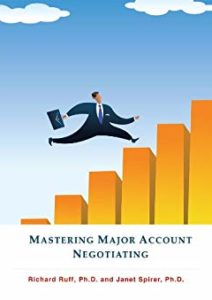It’s a common idea that sales training can’t be done online. While this isn’t necessarily true, it is a caution well taken. Richard Ruff, Ph.D., interviewed by John Golden, explores the positives and negatives of online sales training.
This expert sales interview discusses online sales training
- Old versus new online training
- The importance of going digital
- How to save time and money on training
- Integrating coaching
- An online sales training description
Old vs. New:
The online training that you do today, because of technology, can be different than the online training of yesterday. The online training of yesterday was very awkward. It was often filmed actors portraying general scenarios. It was difficult to customize and difficult to edit. Today, with the advances in avatar software, the game has changed. You can use this software, and customize whatever training you want to do for each client. This is especially important for complex sales, not to mention faster and cheaper overall.
Go Digital:
These days, more and more salespeople are working remotely. They don’t travel to meet the customer, rather they operate online and make sales over the phone or internet. And yet, a lot of sales training still focus on how to sell face to face. Being able to do online sales training actually helps salespeople sell online.
Save Time and Money:
One of the massive benefits of online sales training is that, for larger companies especially, it can be nearly impossible to do in-person training when you have a thousand employees to train. “People are familiar with the technology and feel comfortable operating in that environment,” said Ruff. “And, you have a shot at actually doing it from a price perspective, and a time perspective.” You don’t have to waste valuable time and fiscal resources trying to coordinate travel, organize an event, and put on a training. Things like that eat up cost and waste everyone’s time.
The Coaching Component:
If you look at coaching, everyone buys the idea and understands the importance of coaching. But, the reason why training isn’t done as much as it should be is often because of time. “If you think you can do skill coaching once a month, it’s just not going to work. With online training, you have to have an integrated coaching component, and you have to do the coaching online, or you’ll probably run out of time.”
What does it look like?
So, what exactly does an online training experience look like? They’re usually videos that are designed by an avatar based software package, rather than using live actors. The curriculum varies, but it usually starts with a fundamental topic that is broken down into more basic skills. “It looks at the best practices that we know are absolutely true across industries,” said Ruff. “It’s not, at this point in the evolution of history, that we don’t know what the right answer is. We fully do. So, it’s an issue of how can we help people to get the best practices and develop a common language, and develop the skills to execute that. All online learning does is provide the knowledge.”
For more information on the benefits and how to best utilize online sales training, watch the full expert sales interview!
About our Host:
John is the Amazon bestselling author of Winning the Battle for Sales: Lessons on Closing Every Deal from the World’s Greatest Military Victories and Social Upheaval: How to Win at Social Selling. A globally acknowledged Sales & Marketing thought leader, speaker, and strategist. He is CSMO at Pipeliner CRM. In his spare time, John is an avid Martial Artist.
Pipeliner CRM empowers online sales training. Get your free trial of Pipeliner CRM now.











Comments